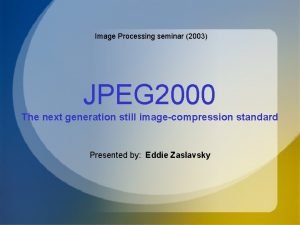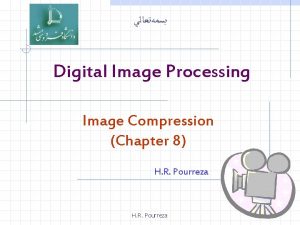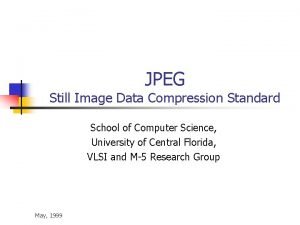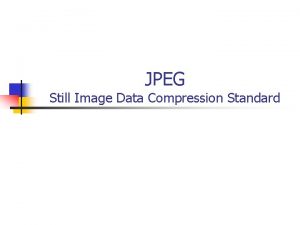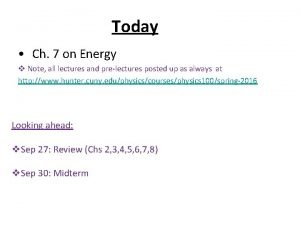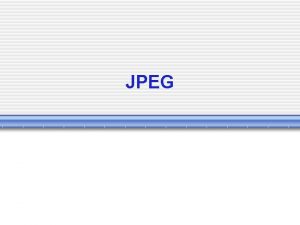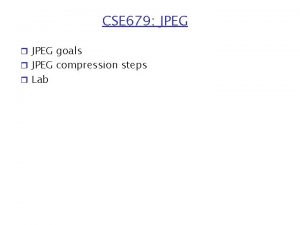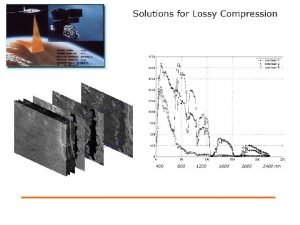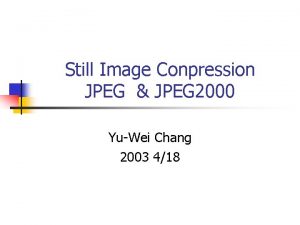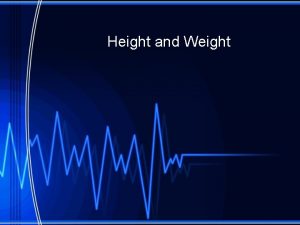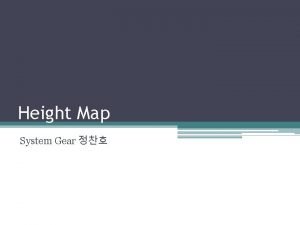JPEG 2000 Image Type Image width and height











- Slides: 11

JPEG 2000 • Image Type • Image width and height: 1 to 232 – 1 • Component depth: 1 to 32 bits • Number of components: 1 to 255 • Each component can have a different depth • Each component can have different spans • Some Application Requirements • Compression: lossless, visually lossy • Progressive spatial resolution and quality resolution • Security (access protection, identification, integrity) • Error resilience

JPEG 2000 • Some application requirements • Strip processing • Information embedding • Repetitive encoding/decoding • ROI encoding/decoding (static and dynamic) • Fast/Random data access • Embedded block coding with optimized truncation • Subbands partitioned into equal blocks • Blocks encoded independently • Post process to determine how each block’s bitstream should be truncated • Final bitstream composed of a collection of layers

Lossy Video Compression • Reducing spatial and temporal redundancy • Why not a 3 D DCT? • 2 -stage processing – interframe and intraframe coding I(x, y, t-1) I(x, y, t) Motion Estimation Motion vector (u, v) finding corresponding pixels Motion Compensation E(x, y, t)=I(x, y, t)-I(x-u, y-v, t-1) DCT Coding

Motion Compensation (x, y) N M (x, y) p p Macroblock (16 x 16) (x, y) (x+u, y+v) Minimize MAE Reference picture

Motion Estimation • Algorithm 0: full search • Algorithm 1: 2 D-logarithmic search • Partition the [-p, p] rectangle into a [-p/2, p/2] rectangle and the rest • Compute the MAE function at the center and 8 perimeter points of the [-p/2, p/2] rectangle. Let the points be d 1 pixels apart • Find the point with the minimum MAE • Start with this location and repeat the above steps, but reduce the distance to d 1/2 • Repeat until the k-th search when the distance between the points is 1 pixel • Complexity? • When will this algorithm perform poorly?

Motion Estimation • Algorithm 2: Hierarchical Motion Estimation • Make 2 progressively low-resolution and downsampled versions of the current frame and the reference frame • Let macroblock of reference frame be located at (x, y) • Corresponding macroblocks are located in (x/2, y/2) and (x/4, y/4) for Level 1 and Level 2 • Let the size of the Level 0 macroblock be 16 X 16 • Let the motion vector have a dynamic range of p pixels • Estimate motion vector from the Level 2 image, using a macroblock of 4 x 4 and a search space of [-p/4, p/4]. • Let MAE be minimized at (u 2, v 2)

Motion Estimation • At Level 1, perform a motion vector search on 8 x 8 macroblocks • The search is centered at (x/2+2 u 2, y/2+ 2 v 2) • The search space is [-1, 1] • Let the minimal MAE be at (u 1, v 1) • At Level 0, perform a motion vector search on 16 x 16 macroblocks • The search is centered at (x+2 u 1, y+ 2 v 1) • The search space is [-1, 1] • Let the minimal MAE be at (u 0, v 0 v) • Complexity? Tradeoffs? • When will the algorithm not perform well?

Matching Criteria • Pixel Difference Classification • Pixels in the macroblock of the current frame: C(x+k, y+l) • Those in the reference frame: R(x+i+k, y+j+l) • PDC(i, j)= k l. Tij (k, l) where Tij (k, l) = 1 if the difference is < t and 0 otherwise • Motion vector is defined for pixels with maximum PDC • If t = 2 p the binary form of PDC is: BPDC(i, j)= k l and{xnor(Cp(x+k, y+l), Rp(x+i+k, y+j+l))} where Cp and Rp are the 8 - p most significant bits of C and R • If more weight are assigned to the more significant bits • BPROP(i, j)= k l xor(Cp(x+k, y+l), Rp(x+i+k, y+j+l)) • What is the performance difference?

Matching Criteria • Bit-plane matching • Let F be a frame • Filter F with convolution kernel K giving G • Example: K(i, j) = 1/25 if i, j [1, 4, 8, 12, 16], 0 otherwise • Compute binary frame F(i, j) = 1 if F(i, j) G(i, j), 0 otherwise • BPM(i, j)= 1/MN k l xor(C(x+k, y+l), R(x+i+k, y+j+l)) • Comparison: 720 X 480, 30 fps, [-15, 15] Search MAE BPM-32 Full search 29. 89 3. 03 1. 16 Logarithmic 1. 02 364. 45 300. 30

Basics of MPEG • Picture sizes: up to 4095 x 4095 • Most algorithms are for the CCIR 601 format for video frames • Y-Cb-Cr color space • NTSC: 525 lines per frame at 60 fps, 720 x 480 pixel luminance frame, 360 x 480 pixel chrominance frame • PAL: 625 lines per frame at 50 fps, 720 x 576 pixel luminance frame, 360 x 576 pixel chrominance frame • SIF (source input format) for digital TV • Luminance resolution: 360 x 240 pixels at 30 fps or 360 x 288 pixels at 25 fps • Chrominance resolution: half the luminance resolution in both dimensions

Basics of MPEG • Macroblocks in MPEG • Minimum coded unit • Interleaving: 4 8 x 8 blocks of luminance 1 8 X 8 block of Cb, 1 8 X 8 block of Cr • Maximum block dimension: 16 • Other parameters (constrained parameter bit stream) • Pixel rate: 30 pps • Motion vectors: 64 pixels (half-pixel resolution) • Bit rate: 1856 kbits/s
 Jpeg 2000 compressor
Jpeg 2000 compressor Length width and height of a rectangular prism
Length width and height of a rectangular prism It encloses volume height width and depth
It encloses volume height width and depth Lossy compression in digital image processing
Lossy compression in digital image processing Jpeg still image data compression standard
Jpeg still image data compression standard Jpeg still image data compression standard
Jpeg still image data compression standard Surface area of parallelogram
Surface area of parallelogram Base x height
Base x height What is density
What is density A 1000 kg car and a 2000 kg car is hoisted the same height
A 1000 kg car and a 2000 kg car is hoisted the same height Height of height gauge at level crossing
Height of height gauge at level crossing Jpeg disadvantages
Jpeg disadvantages
